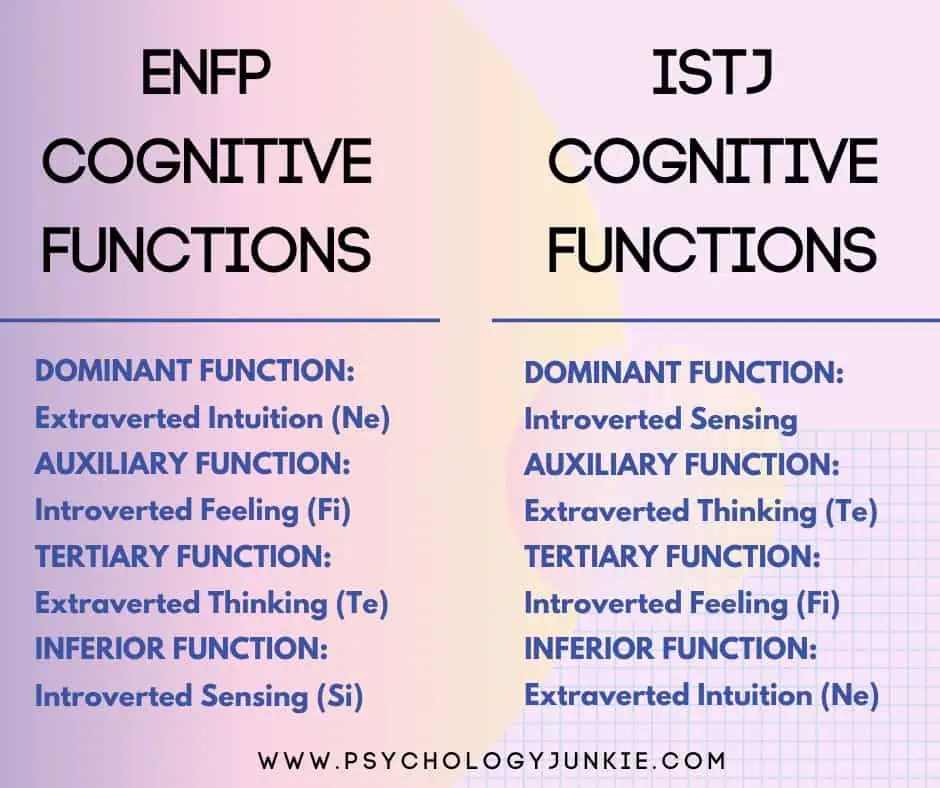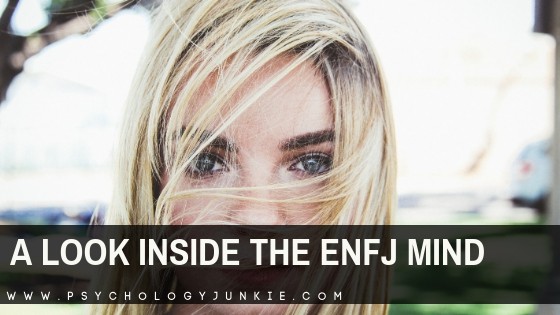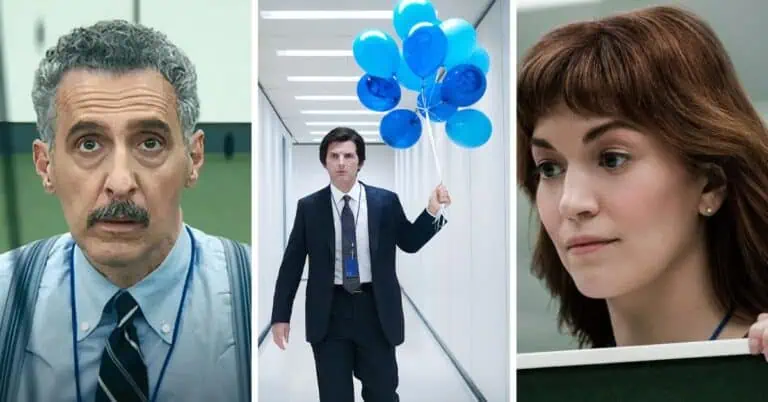The ENFP and ISTJ Relationship: When Opposites Attract
In my years as an MBTI® practitioner, I’ve found again and again that people are romantically attracted to their opposites. If I had a nickel for every time I saw an ENFP/ISTJ relationship, or ESTP/INFJ relationship, or INTP/ESFJ relationship, I’d have….a lot of nickels.
Why is this? I’ve concluded that it comes down to us naturally seeking the yin to your yang, the day to your night – a complementing force that offers balance. With that in mind, today we’re going to delve into the intriguing world of the ENFP and ISTJ relationship – a unique symphony of contrasts. Will it be harmony or discord that prevails? Join us as we unravel this unique blend of personalities.

Not sure what your personality type is? Take our comprehensive personality questionnaire here. Or you can take the official MBTI® here.
Understanding ENFPs: The Chaos Goblins of Personality Types
If you want to understand an ENFP you’ve got to think of someone like Robin Williams or Walt Disney—excitable, curious, spontaneous, and visionary. They’re all about exploration, creativity, and pushing boundaries just to see what happens.
What Makes an ENFP Tick?
- Extraverted (E): People = energy. ENFPs light up when they’re engaging with others, exchanging wild ideas, and jumping headfirst into new experiences. While they need some alone time, they’re more focused on teh outer world than the inner world.
- Intuitive (N): Facts? Sure, they exist. But patterns, possibilities, and the bigger picture? That’s where the real magic is. ENFPs don’t care about the fine print; they want to know where an idea could go.
- Feeling (F): If it doesn’t align with their personal values, it’s not happening. ENFPs prioritize emotions, authenticity, and gut instincts over cold, hard logic. This doesn’t mean they can’t be logical, but the priority will be on looking to the heart first.
- Perceiving (P): Planning? Structure? Schedules? Not really their thing. ENFPs prefer to keep their options open, flowing wherever inspiration takes them.
Peak ENFP Mode:
- Stumbling into a deep philosophical conversation at 3 AM.
- Deciding on a whim to start a new creative project… and maybe (probably) never finishing it.
- Chaotically jumping from one passion to the next, always seeking the next spark of excitement.
ENFPs are all about freedom—freedom to think, feel, and explore without anyone trying to box them in. They’re fiercely individualistic, which means they’re not going to change just to fit in. They’ll dye their hair pink at 35 just because it feels right. They’ll adopt a snail and name it Mr. Pickles. Their world is a whirlwind of ideas, emotions, and unpredictable adventures, and they like it that way.
Understanding ISTJs: The Human To-Do List in Action
If ENFPs were golden retrievers, ISTJs would be the steady, serious Irish Wolfhounds. Practical, responsible, and fully prepared for any scenario, ISTJs take life seriously. They’re the ones making sure society doesn’t collapse under the weight of chaos and indecision.
What Makes an ISTJ Tick?
- Introverted (I): People are fine, but alone time? Better. ISTJs recharge through solitude, reflection, and getting things done without interruptions.
- Sensing (S): Facts, details, and reality > abstract theories. If there’s no concrete evidence, they’re not buying. Their world is built on what’s real, not speculation.
- Thinking (T): Decisions are based on logic, reason, and efficiency. Feelings don’t factor in unless they’re directly useful.
- Judging (J): Plans, schedules, and structure give ISTJs life. They don’t just like order—they need it. If there’s a system, it will be followed. If there isn’t? They’ll make one.
Peak ISTJ Mode:
- Making lists for everything (including things they’ve already done, just for the satisfaction of checking them off).
- Side-eyeing someone who’s five minutes late like it’s a personal betrayal.
- Handling responsibilities before they become problems—because preparation is everything.
ISTJs function best when the world is predictable. They thrive on reliability, duty, and making sure everything is done the right way (which, coincidentally, is usually their way). If ENFPs are here to shake things up, ISTJs are the ones holding it all together.
The Cognitive Functions of ENFPs and ISTJs

In the world of personality theory, cognitive functions are the essence of our psychological makeup, the cogs and wheels driving our thoughts, feelings, and actions. They are our unique ways of perceiving the world and making decisions. Each of us has a set of four primary cognitive functions, ordered in a hierarchy of dominance. Imagine these functions as a team of players inside our minds, each with its peculiar strengths and weaknesses, all working together to navigate the voyage of life.
ENFP Cognitive Function Stack: The Chaos Innovator
Dominant: Extraverted Intuition (Ne) – “What If?” Mode
ENFPs don’t see one possibility; they see all of them—simultaneously. Their brains are like high-speed internet browsers with 57 tabs open at all times. They’re constantly scanning the environment for new ideas, hidden patterns, and exciting what-ifs.
This is why:
✅ They come up with wild, creative solutions no one else would think of.
❌ They start a million projects and finish, uh… fewer than that.
Auxiliary: Introverted Feeling (Fi) – “Stay True to Yourself” Mode
Deep down, ENFPs are guided by an unshakable internal moral compass. Their decisions aren’t about cold, hard logic—they’re about what feels right.
This is why:
✅ They stand firm on their values, even if the whole world disagrees.
❌ They sometimes take things personally that were merely constructive criticism.
Tertiary: Extraverted Thinking (Te) – “Okay, Time to Get It Together” Mode
ENFPs can be structured and productive… when they actually engage this function. Te helps them implement their grand ideas, but it’s third in line, so they don’t always use it consistently.
This is why:
✅ They can buckle down and organize their chaotic creativity when absolutely necessary.
❌ They’d really rather not.
Inferior: Introverted Sensing (Si) – “Wait, What Happened Again?” Mode
Si is all about recalling past experiences and sticking to what’s familiar. Since it’s ENFPs’ weakest function, they tend to be very bad at routine and tradition.
This is why:
✅ They’re always chasing the next adventure.
❌ They forget where they put their keys every single day.
ISTJ Cognitive Function Stack: The Stability Master
Dominant: Introverted Sensing (Si) – “The Keeper of the Past” Mode
ISTJs trust what’s tried and true. They don’t waste time reinventing the wheel when the existing one works just fine. They remember details, value consistency, and build their lives around stability.
This is why:
✅ They’re the rock you can rely on.
❌ They’re allergic to unnecessary change.
Auxiliary: Extraverted Thinking (Te) – “Get It Done” Mode
ISTJs love efficiency, and Te helps them structure their world logically. If there’s a problem, they don’t whine about it—they fix it.
This is why:
✅ They run on schedules, plans, and checklists.
❌ They have zero patience for incompetence.
Tertiary: Introverted Feeling (Fi) – “Deep Down, I Care” Mode
While ISTJs don’t look emotional, they have an inner value system that does influence their decisions. They just don’t wear it on their sleeve like ENFPs do.
This is why:
✅ They’re deeply loyal to the people and causes they care about.
❌ They’d rather explode internally than talk about their feelings.
Inferior: Extraverted Intuition (Ne) – “Wait… What If?” Mode
Ne is the function of abstract ideas and endless possibilities. Since it’s ISTJs’ weakest function, they’re not naturally comfortable with theoretical discussions or major uncertainty.
This is why:
✅ They like things to be predictable and well-defined.
❌ They think ENFPs are absolute chaos gremlins.
Why This Matters in a Relationship
Since ENFPs lead with possibilities and ISTJs lead with facts, they often talk past each other:
💡 ENFP: “Omg, what if we dropped everything and moved to Italy?”
📊 ISTJ: “We live here. We work here. What do you mean ‘drop everything’?”
🔍 ISTJ: “That’s not how things are done.”
🎭 ENFP: “But… what if we did it differently?”
ENFPs want freedom and exploration. ISTJs want structure and consistency. They challenge each other in ways that can be both incredibly frustrating and incredibly rewarding.
When balanced well:
✅ ENFPs help ISTJs loosen up and see beyond routine.
✅ ISTJs help ENFPs bring structure to their endless ideas.
When not balanced well:
❌ ISTJs see ENFPs as irresponsible daydreamers.
❌ ENFPs see ISTJs as rigid killjoys.
But when they find that sweet spot? The ISTJ keeps life grounded, and the ENFP makes sure it’s never boring.
The Benefits of the ENFP & ISTJ Relationship
At first glance, an ENFP-ISTJ relationship might seem like a recipe for frustration. One needs spontaneity, the other craves structure. One leaps before looking, the other triple-checks the safety harness. But beneath the surface, these differences don’t just clash—they complement each other, creating a dynamic that pushes both partners toward growth.
ENFPs bring adventure, curiosity, and fresh ideas that nudge ISTJs out of their comfort zones. In return, ISTJs offer stability, practicality, and a grounded perspective that helps ENFPs turn their dreams into reality. When these two find a rhythm, they create a relationship that balances excitement with reliability.
ISTJs thrive on routine, while ENFPs love breaking it—but this contrast can be surprisingly harmonious. The ISTJ’s structured approach brings a sense of order to the ENFP’s whirlwind of ideas, while the ENFP’s flexibility helps ISTJs loosen their grip on predictability. Instead of clashing, they fill in each other’s blind spots.
With their different ways of seeing the world, these two introduce each other to perspectives they might never have considered. ISTJs help ENFPs see the value of patience and consistency, while ENFPs remind ISTJs that sometimes, the best things in life come from taking risks and embracing the unknown. Together, they expand each other’s horizons.
They also make an incredibly well-rounded team. ISTJs excel at handling the details and ensuring everything is executed efficiently, while ENFPs bring creative problem-solving and a big-picture mindset. This dynamic means they rarely leave any angle unexplored—what one lacks, the other makes up for.
And finally, while it takes time to truly understand each other, once they do, the connection can run deep. The ENFP’s warmth and emotional insight help bring out the softer, often-hidden side of the ISTJ. In turn, the ISTJ’s loyalty and quiet depth create a relationship built on mutual trust and security. Over time, what started as frustrating differences can transform into an unshakable bond.
ENFPs, ISTJs, and Introverted Feeling: A Strong Cord of Connection
ISTJs often get labeled as rigid, unemotional, or robotic—but that’s far from the truth. Beneath their no-nonsense exterior is a deeply personal value system that guides their decisions, even if they don’t express it openly. They care about doing the right thing, and in relationships, they want to feel understood for who they really are—not just for what they do.
ENFPs, on the other hand, are emotional detectives. With their strong Introverted Feeling (Fi), they instinctively pick up on what matters most to others, even when those people struggle to express it themselves. They care deeply about individuality and authenticity, and when they see the depth of an ISTJ’s values, they respect and protect it.
This shared connection through Introverted Feeling creates an emotional bridge between them. The ISTJ, who may struggle to articulate their deeper emotions, finds comfort in an ENFP’s ability to see through their practical exterior. And the ENFP, who craves emotional honesty and depth, finds reassurance in the ISTJ’s quiet but steadfast loyalty.
It may not be the loudest, most expressive connection, but it’s one that runs deep—built not on grand gestures, but on the quiet certainty that they get each other, even when the rest of the world doesn’t.
5 Roadblocks in the ENFP & ISTJ Relationship (And How to Overcome Them)
No relationship is all sunshine and rainbows—especially when you pair a free-spirited adventurer with a careful planner. ENFPs and ISTJs bring out the best in each other, but they also push all the right buttons (and sometimes, the wrong ones). Here are five common roadblocks they might hit, along with ways to get through them.
Communication Styles – ENFPs are open books, pouring out their emotions and thoughts freely, while ISTJs tend to express love through actions rather than words. This difference can lead to misunderstandings, with ENFPs feeling ignored and ISTJs feeling overwhelmed. The fix? ENFPs need to recognize that ISTJs do care, even if they don’t always say it outright, while ISTJs should make an effort to verbalize their emotions more often. A simple “I appreciate you” goes a long way.
Different Rhythms – ENFPs are all about spontaneity, while ISTJs rely on stability and routine. This can cause frustration when one partner wants to jump into an impromptu road trip while the other just wants to stick to the plan. Instead of seeing this as a clash, they should view it as a balancing act—ENFPs bring excitement, ISTJs bring stability. Finding ways to compromise (like scheduling some planned adventures) can keep both sides happy.
Dealing with Change – Change is an adventure for an ENFP and a nightmare for an ISTJ. When life throws curveballs, ENFPs may rush toward the unknown with enthusiasm, while ISTJs dig their heels in, preferring the comfort of what’s familiar. The key here is trust. ENFPs should reassure ISTJs by maintaining some consistency, and ISTJs should occasionally embrace change to keep things exciting. Setting aside time for both structured activities and open-ended exploration ensures neither partner feels stifled.
Planning vs. Living in the Moment – ISTJs want a five-year plan. ENFPs decide what they’re doing five minutes before they do it. When it comes to big life decisions, this difference can lead to some serious tension. The best approach? A mix of both. ISTJs can benefit from allowing some flexibility in their plans, while ENFPs can work on being more intentional about long-term commitments. Compromise is key—plan the big stuff, but leave room for spontaneity.
Introversion vs. Extroversion – ENFPs recharge through people, ISTJs recharge through not people. Social events can quickly become a battleground if the ENFP wants to go out every weekend and the ISTJ would rather stay home with a book. The trick is respecting each other’s energy levels. ENFPs should recognize when their ISTJ needs solitude without taking it personally, and ISTJs should occasionally step outside their comfort zones to join in on social activities. A balance of together time and alone time ensures both partners get what they need.
Being Sensitive to Each Other’s Weak Spots
One of the biggest challenges in an ENFP-ISTJ relationship? Each partner’s biggest strength is also the other’s biggest weakness. This means, without realizing it, they can easily overwhelm each other just by being themselves.
ISTJs lead with Introverted Sensing (Si)—they track details, stick to routines, and remember exactly how things have always been done. Meanwhile, ENFPs are terrible at these things. If an ISTJ bombards their ENFP partner with an avalanche of specifics—dates, rules, step-by-step instructions—the ENFP might start short-circuiting, feeling overwhelmed, frustrated, or defensive.
On the flip side, ENFPs lead with Extraverted Intuition (Ne)—they bounce between ideas at lightning speed, chasing possibilities and brainstorming a hundred things at once. ISTJs, however, do not thrive in chaos. If an ENFP starts rapid-firing every thought in their brain, the ISTJ might shut down, get irritable, or feel like they’re being dragged into a world of unnecessary hypotheticals.
This doesn’t mean either partner should suppress who they are. It does mean they should practice a little consideration.
If you’re an ENFP, slow down once in a while. When you’re rattling off ideas for your next vacation, pause and check in with your ISTJ:
- “Is this too many ideas at once?”
- “What vacations have you really enjoyed in the past?”
- “How can I pick a place that fits your preferences?”
This gives your ISTJ partner space to process rather than feeling steamrolled by an idea tornado.
If you’re an ISTJ, be mindful of how much detail you’re expecting your ENFP to absorb at once. Instead of assuming they’re tracking every step, pause and ask:
- “Do you need me to slow down?”
- “Do you have any questions?”
- “Is there a way you’d like to do this differently?”
And when your ENFP does want to approach something in a new way, ask yourself—does this actually matter? If they’re doing something differently but it’s not causing a real problem, try letting it go instead of correcting or critiquing.
At the end of the day, a little patience and communication can make all the difference. ENFPs and ISTJs may have wildly different strengths, but when they learn to respect each other’s processes instead of overwhelming each other, they create a relationship that blends structure with spontaneity in the best possible way.
What Are Your Thoughts?
We would love to hear your insights and experiences as well! Have you been in an ENFP and ISTJ relationship? Or do you know someone who has? What challenges and joys have you encountered? Your unique stories and perspectives enrich our understanding of these intriguing personality dynamics. Please feel free to share your thoughts, experiences, or questions in the comments below. Your voice matters to us.
Other Articles You Might Enjoy:
Here’s How You’re Misunderstood in Relationships, Based On Your Myers-Briggs® Personality Type
What Each Myers-Briggs® Personality Type Needs in a Long-Term Relationship
Your Biggest Relationship Fear, Based On Your Myers-Briggs® Personality Type
References:
The 16 Personality Types: Descriptions for Self-Discovery by Linda V. Berens and Dario Nardi (1999, InterStrength)
16 Ways to Love Your Lover: Understanding the 16 Personality Types So You Can Create a Love That Lasts Forever by Otto Kroeger & Janet M. Thuesen (1994, Dell Publishing)









Can you do this for ESTP and INFJ? Our 18 year marriage has been incredibly hard…
I’ve written an article for this pairing! I’m sorry that it’s been so difficult, and I hope the article can help! It’s right here: https://www.psychologyjunkie.com/infjs-estps-fall-love-joys-struggles/
I (ENFP) fall for an ISTJ. We’ve known each other for about 5 years now. I told him I like him and he just smiled. All this time I’m trying to be patience, but I start to lose my patience. What are we actually?
I asked him once, he said if he likes someone or vice versa, he would just know and won’t say anything. While I understand maybe labellings isn’t his preference, I’d like to know if I’m wasting my time. He doesn’t text, doesn’t make plan…basically nothing, but I know we feel good with each other’s presence. I don’t want to push it but I think 5 years is cutting it.
Love it! 🎯
13 years of marriage ISTJ (she) with ENFP (he) ☺️
Discovering MBTI was a real game-changer for us. All you said in this article is true and working for us.
Thank you for doing this and helping people to know themselves and than understand others.
I (an ISTJ) am roommates with an ENFP. While not quite the same as a relationship, our decision to live together has brought some of the same challenges as in this article. It was extremely helpful for me. Thank you!
Two things I’ve learned from being roommates with an ENFP:
1: For my own sanity, I have to know when to say “no” to another event or another gathering at our apartment, but I also need to explain why (ex. It’s at the end of a stressful week and I know I’ll need alone time to recharge) and propose an alternative (ex. Maybe this friend will go with you; We can host the game night this other weekend). I appreciate the invitations and have learned to balance her need for social time with me and my need for uninterrupted time by myself.
2: My roommate constantly says she wants to be better organized, but doesn’t like it when I give suggestions. However, if I just explain how I solve that organizational problem for myself (ex. I drop my keys in this basket by the door whenever I get home) and then consistently do it, she often ends up trying it for herself. (It’s been a long time since we had to hunt for lost keys!) It doesn’t always work (The dishwasher is only a foot from the sink – just put the dishes in there for Pete’s sake!), but I’ve also leaned to be okay with an apartment that actually looks like we live here (To an extent – let’s have ONE mail pile, please.).
We’re definitely both growing from our time living in the same apartment. I’ve found there can be a lot of fun in an unexpected, impromptu balloon fight, and she’s learned how helpful a wall calendar is. Now we just need to reach a consensus about how often we redecorate. 😆